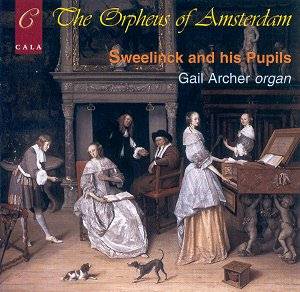On the face of it this
is an attractive, if rather short, collection
of music by Sweelinck and his most famous
students Scheidt and Scheidemann. It
is even performed on an iconic meantone
organ; Charles Fisk’s creation for Wellesley
College, at that time, (possibly still?)
the largest all-meantone organ in the
US, (some dual-temperament organs are
larger). It is one of the crowning achievements
of Fisk, a pivotal figure in American
organ building who died just two years
after its completion. It sounds well
here, reminding us that some builders
really can make beautiful instruments
in impossibly dry acoustics.
The weak link however
is the organist Gail Archer, recently
appointed Professor of Organ at Manhattan
School of Music in New York City. Unfortunately
her fundamental problems with the understanding
and performance of this music are clear
from the opening scales of the C major
Sweelinck Toccata. Archer does
not speak the language of this music
and the result is dull. Her technique
allows her none of the subtlety of touch
required; there is no evidence here
that she knows how to express a strong
beat or (more especially) a weak beat,
or a crescendo or diminuendo. The result
is that the music becomes impossibly
accented and constantly focused on the
smallest note values. Even the left
hand cannot differentiate between the
two minim beats which make up much of
its role in Malle Sijmen, far
less four crochet beats at other points;
all the accents are completely equal.
Her use of early fingering is clearly
audible but it seems that she has little
idea how to use it to a musical end.
Her shaping of rhetorical figures is
non-existent, as is her feeling for
affekt. Listen to Archer’s Scheidemann
Magnificat and compare with Julia
Brown’s recording of the same work on
Naxos. The difference between Archer’s
awkward, agricultural playing and Brown’s
subtle, beautifully controlled, and
expressive playing is like night and
day. Archer fails to articulate the
Cantus Firmus in the Pedaliter variation;
the repeated notes all but disappear.
The Sweelinck Ricercar is a travesty,
with a silly, contrived registration
scheme, (begins with the Principal,
visits around eight other registrations
before ending up on the plenum with
the pedal reeds), and is unstable and
disjointed. At one point (6:16) the
pedal takes over the theme and actually
delivers it űberlegato.
There are countless
other better recordings of this music
than this, which is unfortunately let
down by an organist seemingly out of
her depth.
Chris Bragg







